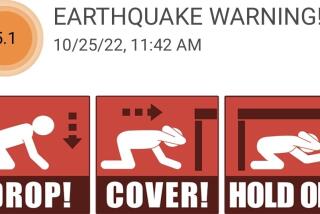Editorial: It would be reckless to pull federal funding for an earthquake early warning system
Experts can’t predict earthquakes, but they can warn you that they’re coming. For a dozen years, West Coast scientists working with the United States Geological Survey have been developing an earthquake early warning system — called ShakeAlert — that could provide anywhere from a few seconds to a few minutes of warning not only about the shaking that’s imminent but also about its intensity.
That’s enough time to stop a train in its tracks, let an elevator open at the nearest floor or warn your dentist to pull the drill out of your mouth. But just as a pilot program for the system is ramping up, President Trump’s budget would eliminate $10 million in federal funding for it and end the U.S. Geological Survey’s involvement in it. That would be a colossal mistake. Pulling federal money and federal scientific support would not just slow the ShakeAlert project, it would likely kill it altogether.
The system received $10 million in state funding this year; in addition, the federal government has put in $23 million over the past three fiscal years. The system needs the continued federal funding to finish building out an already extensive network of ground sensors as well as seismic stations to transmit the information from the sensors. Even more crucial is money for the annual maintenance and upgrade of the system’s software and hardware and for researchers and other staff who will work on it when it is fully operational throughout the state.
In addition, ShakeAlert, which will operate across California, Washington, and Oregon, depends on the U.S. Geological Survey to coordinate the scientific efforts across those states and to authorize issuing the warning alerts to citizens.
Early warning systems detect the seismic waves rippling outward from the rupture in the earth, calculate the maximum intensity of the expected shaking and send alerts to electronic devices — smart phones, public address systems, computers, televisions — faster than the seismic waves can travel through the ground. The farther you are from the epicenter, the more time you have between the alert and the shaking. But even a few seconds is enough time to find a place to, literally, duck and cover.
Los Angeles City Hall is already connected to the system, as is the fire station at Universal City. Of course there haven’t been any major quakes recently in this area. But researchers in San Francisco got eight seconds of warning when a magnitude 6.0 quake hit Napa in 2014. More institutions here are expected to join the pilot program if funding stays in place. The city of Los Angeles has aggressively supported the system. It invested $5 million to set up a network of 125 seismic stations in southern California that have sensors and transmitters. The challenging part — for all of California and the rest of the West Coast — is putting in place the technology to send out the warnings to masses of people at once and extremely quickly. It’s doable. Japan has a system in place.
The system has bipartisan support among members of Congress from California. They should work hard to add federal funding to a warning system that could save lives and crucial infrastructure during a catastrophic earthquake.
Follow the Opinion section on Twitter @latimesopinion or Facebook
More to Read
A cure for the common opinion
Get thought-provoking perspectives with our weekly newsletter.
You may occasionally receive promotional content from the Los Angeles Times.










